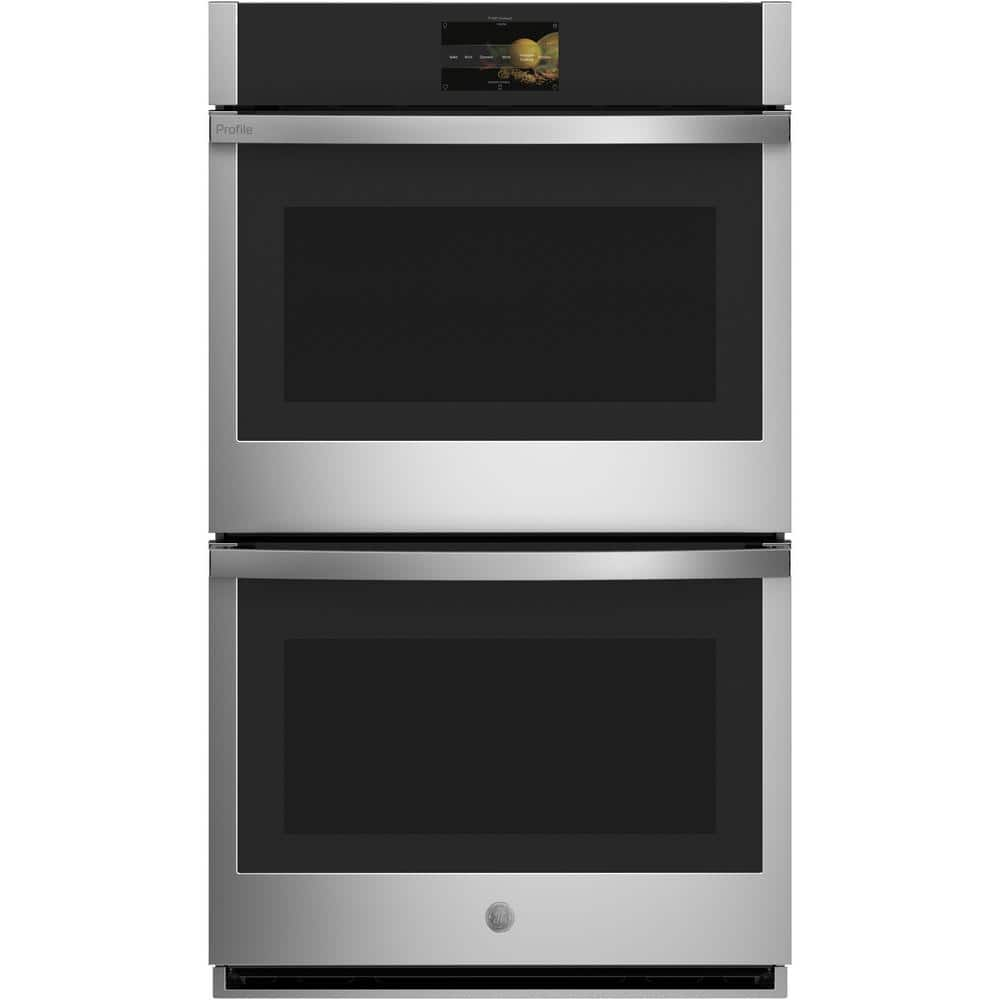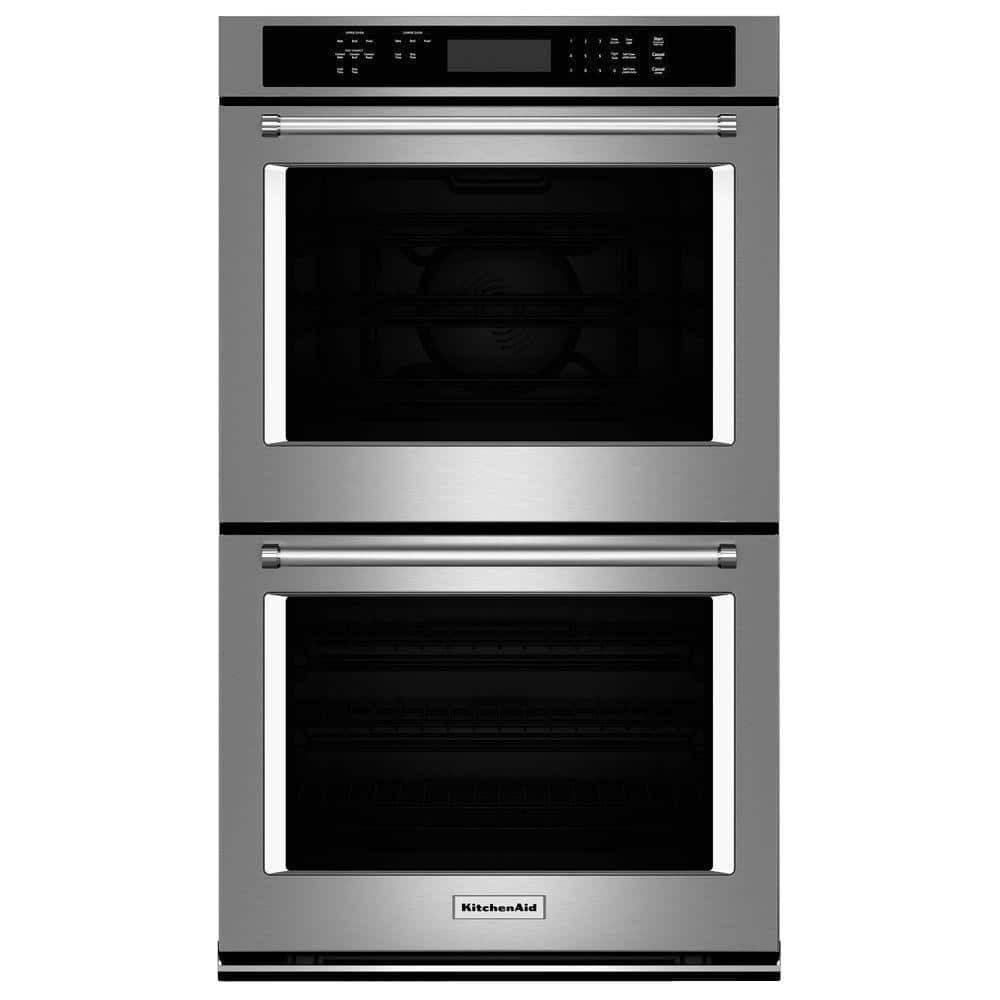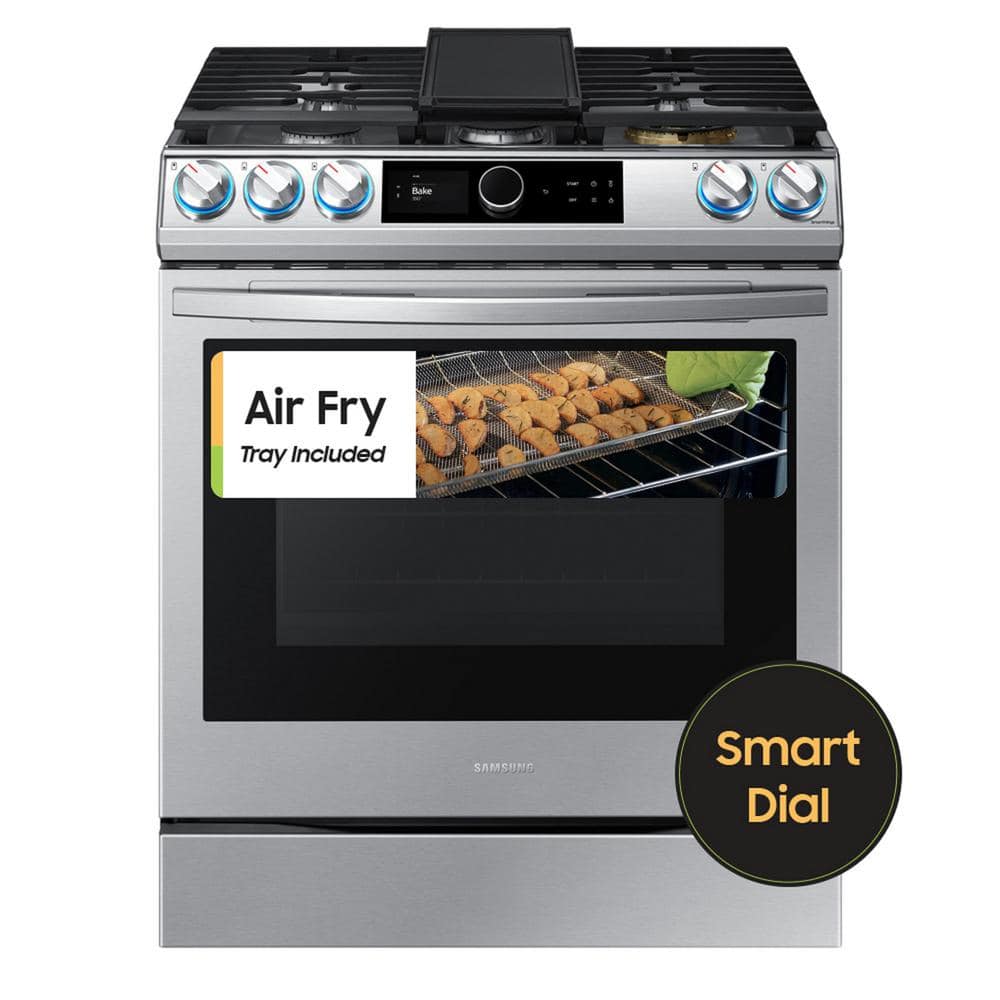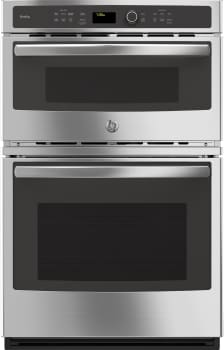GE Profile 30 in. Smart Double Electric Wall Oven with Convection Self-Cleaning in Stainless Steel
-
( 9 Reviews )Rated 4.89 out of 5 based on 9 customer ratings09
Precision cooking automatically adjusts temperature and cook time. 7 in. touch screen makes it easy and fun to program the oven. Contact your local store with Order # to schedule installation.
-
Fireking Large Stainless Steel Pizza Oven – Aldi UK
Rated 5.00 out of 508Fireking Large Stainless Steel Pizza Oven – Aldi UK
Rated 5.00 out of 508 -
GE PK7800SKSS 27 Inch Combination Electric Wall Oven with 6 Total cu. ft. Capacity
Rated 5.00 out of 503GE PK7800SKSS 27 Inch Combination Electric Wall Oven with 6 Total cu. ft. Capacity
Rated 5.00 out of 503
The GE Profile 30 in. Electric Convection Double Wall Oven provides a full 5.0 cu. ft. capacity per oven for ample cooking space. GE Profile products offer the best in contemporary design matched with the latest in appliance technologies to transform the way you live. Sporting a bold, dramatic look and state of the art features, this collection provides the perfect combination of style and innovation throughout your kitchen.
- Fit Guarantee – Replacing a similar wall oven from GE Appliances or another brand GE wall ovens are guaranteed for an exact fit or GE Appliances will pay up to $300 toward modifications
- Precision cooking modes – Set your oven to autopilot, even when cooking the most intricate dishes, with advanced technology that provides simple instructions then automatically adjusts temperature and cook times to deliver perfect results
- Brilliant Touch 7 in Display – A bright, interactive touch screen makes it fun and easy to program the oven
- True European Convection with Direct Air – Optimize your results on roasts, chicken, turkey and other special-occasion favorites, with the only cooking system that delivers true top-down convection
- No preheat option – Save time with a variety of precision cooking modes that eliminate the need for preheating
- Hot air frying – Achieve crispy, never greasy, fried food results in your oven without the oil
- Anywhere control with remote notifications – Save time by conveniently preheating and monitoring your oven from anywhere using the GE Appliances Kitchen app
- Never scrub, heavy-duty smooth glide racks – Easily remove even the heaviest dishes with a roller rack thats engineered to glide seamlessly out of the oven
- Scan-to-cook technology – Prepare your favorite packaged foods to perfection simply by scanning the barcode on the package with your smartphone and letting your oven adjust settings automatically
- Self-clean oven with optional Steam Clean – Let your oven do the cleaning for you with two ways to eliminate baked on messes
- Precision temperature probe – Monitor the progress of roasts and meats through the GE Appliances Kitchen app on your smartphone for accurately cooked results
- 10-pass hidden bake element – Even baking is assured with heat that covers more surface area
- 10-pass dual-broil element – Large and small dishes brown evenly with two, full-coverage elements
- Double oven convection – Cook more dishes at once and achieve perfectly even results with convection technology in both ovens
- Limited 1-year entire appliance warranty
- PRODUCT AVAILABLE FOR HOME DELIVERY ONLY. Installation is not offered at time of delivery; check with your local The Home Depot with your Order # to schedule installation for this item.
-
Additional information
| Cut-Out Front to Back Depth (in.) | 23.5 |
|---|---|
| Cut-Out Height (in.) | 51.8125 |
| Cut-Out Left to Right Width (in.) | 28.5 |
| Depth With Door(s) Open 90 Degrees (In.) | 48.75 |
| Lower Oven Interior Depth x Height x Width (in.) | 20.25 x 17.375 x 25 |
| Product Depth x Height x Width (in.) | 26.75 x 53 x 29.75 |
| Upper Oven Interior Depth x Height x Width (in.) | 20.25 x 17.375 x 25 |
| Wall Oven Size (in.) | 30 |
| Certifications and Listings | UL Listed |
30 may refer to:
- 30 (number), the natural number following 29 and preceding 31
- one of the years 30 BC, AD 30, 1930, 2030
Cleaning is the process of removing unwanted substances, such as dirt, infectious agents, and other impurities, from an object or environment. Cleaning is often performed for aesthetic, hygienic, functional, safety, or environmental protection purposes. Cleaning occurs in many different contexts, and uses many different methods. Several occupations are devoted to cleaning.
Convection is single or multiphase fluid flow that occurs spontaneously through the combined effects of material property heterogeneity and body forces on a fluid, most commonly density and gravity (see buoyancy). When the cause of the convection is unspecified, convection due to the effects of thermal expansion and buoyancy can be assumed. Convection may also take place in soft solids or mixtures where particles can flow.
Convective flow may be transient (such as when a multiphase mixture of oil and water separates) or steady state (see convection cell). The convection may be due to gravitational, electromagnetic or fictitious body forces. Heat transfer by natural convection plays a role in the structure of Earth's atmosphere, its oceans, and its mantle. Discrete convective cells in the atmosphere can be identified by clouds, with stronger convection resulting in thunderstorms. Natural convection also plays a role in stellar physics. Convection is often categorised or described by the main effect causing the convective flow; for example, thermal convection.
Convection cannot take place in most solids because neither bulk current flows nor significant diffusion of matter can take place. Granular convection is a similar phenomenon in granular material instead of fluids. Advection is fluid motion created by velocity instead of thermal gradients. Convective heat transfer is the intentional use of convection as a method for heat transfer. Convection is a process in which heat is carried from place to place by the bulk movement of a fluid.
An oven is a tool that is used to expose materials to a hot environment. Ovens contain a hollow chamber and provide a means of heating the chamber in a controlled way. In use since antiquity, they have been used to accomplish a wide variety of tasks requiring controlled heating. Because they are used for a variety of purposes, there are many different types of ovens. These types differ depending on their intended purpose and based upon how they generate heat.
Ovens are often used for cooking, usually baking, sometimes broiling; they can be used to heat food to a desired temperature. Ovens are also used in the manufacturing of ceramics and pottery; these ovens are sometimes referred to as kilns. Metallurgical furnaces are ovens used in the manufacturing of metals, while glass furnaces are ovens used to produce glass.
There are many methods by which different types of ovens produce heat. Some ovens heat materials using the combustion of a fuel, such as wood, coal, or natural gas, while many employ electricity. Microwave ovens heat materials by exposing them to microwave radiation, while electric ovens and electric furnaces heat materials using resistive heating. Some ovens use forced convection, the movement of gases inside the heating chamber, to enhance the heating process, or, in some cases, to change the properties of the material being heated, such as in the Bessemer method of steel production.
In philosophy, the self is an individual's own being, knowledge, and values, and the relationship between these attributes.
The first-person perspective distinguishes selfhood from personal identity. Whereas "identity" is (literally) sameness and may involve categorization and labeling, selfhood implies a first-person perspective and suggests potential uniqueness. Conversely, "person" is used as a third-person reference. Personal identity can be impaired in late-stage Alzheimer's disease and in other neurodegenerative diseases. Finally, the self is distinguishable from "others". Including the distinction between sameness and otherness, the self versus other is a research topic in contemporary philosophy and contemporary phenomenology (see also psychological phenomenology), psychology, psychiatry, neurology, and neuroscience.
Although subjective experience is central to selfhood, the privacy of this experience is only one of many problems in the philosophy of self and scientific study of consciousness.
Smart may refer to a high level of intelligence or "street smarts".
"Smart" or SMART may also refer to the following.
Stainless may refer to:
- Cleanliness, or the quality of being clean
- Stainless steel, a corrosion-resistant metal alloy
- Stainless Games, a British video game developer
- Stainless Broadcasting Company, a TV broadcaster based in Michigan, US
- Stainless Banner, the second national flag of the Confederate States of America
Steel is an alloy of iron and carbon with improved strength and fracture resistance compared to other forms of iron. Because of its high tensile strength and low cost, steel is one of the most commonly manufactured materials in the world. Steel is used in buildings, as concrete reinforcing rods, in bridges, infrastructure, tools, ships, trains, cars, bicycles, machines, electrical appliances, furniture, and weapons.
Iron is always the main element in steel, but many other elements may be present or added. Stainless steels, which are resistant to corrosion and oxidation, typically are 18% chromium.
Iron is the base metal of steel. Depending on the temperature, it can take two crystalline forms (allotropic forms): body-centred cubic and face-centred cubic. The interaction of the allotropes of iron with the alloying elements, primarily carbon, gives steel and cast iron their range of unique properties. In pure iron, the crystal structure has relatively little resistance to the iron atoms slipping past one another, and so pure iron is quite ductile, or soft and easily formed. In steel, small amounts of carbon, other elements, and inclusions within the iron act as hardening agents that prevent the movement of dislocations.
The carbon in typical steel alloys may contribute up to 2.14% of its weight. Varying the amount of carbon and many other alloying elements, as well as controlling their chemical and physical makeup in the final steel (either as solute elements, or as precipitated phases), impedes the movement of the dislocations that make pure iron ductile, and thus controls and enhances its qualities. These qualities include the hardness, quenching behaviour, need for annealing, tempering behaviour, yield strength, and tensile strength of the resulting steel. The increase in steel's strength compared to pure iron is possible only by reducing iron's ductility.
Steel was produced in bloomery furnaces for thousands of years, but its large-scale, industrial use began only after more efficient production methods were devised in the 17th century, with the introduction of the blast furnace and production of crucible steel. This was followed by the Bessemer process in England in the mid-19th century, and then by the open-hearth furnace. With the invention of the Bessemer process, a new era of mass-produced steel began. Mild steel replaced wrought iron. The German states were the major steel producers in Europe in the 19th century. American steel production was centred in Pittsburgh; Bethlehem, Pennsylvania; and Cleveland until the late 20th century. Currently, world steel production is centered in China, which produced 54% of the world's steel in 2023.
Further refinements in the process, such as basic oxygen steelmaking (BOS), largely replaced earlier methods by further lowering the cost of production and increasing the quality of the final product. Today more than 1.6 billion tons of steel is produced annually. Modern steel is generally identified by various grades defined by assorted standards organizations. The modern steel industry is one of the largest manufacturing industries in the world, but also one of the most energy and greenhouse gas emission intense industries, contributing 8% of global emissions. However, steel is also very reusable: it is one of the world's most-recycled materials, with a recycling rate of over 60% globally.
A wall is a structure and a surface that defines an area; carries a load; provides security, shelter, or soundproofing; or serves a decorative purpose. There are various types of walls, including border barriers between countries, brick walls, defensive walls in fortifications, and retaining walls that hold back dirt, stone, water, or noise. Walls can also be found in buildings, where they support roofs, floors, and ceilings, enclose spaces, and provide shelter and security.
The construction of walls can be categorized into framed walls and mass-walls. Framed walls transfer the load to the foundation through posts, columns, or studs and typically consist of structural elements, insulation, and finish elements. Mass-walls are made of solid materials such as masonry, concrete, adobe, or rammed earth. Walls may also house utilities like electrical wiring or plumbing and must conform to local building and fire codes.
Walls have historically served defensive purposes, with the term "wall" originally referring to defensive walls and ramparts. Examples of famous defensive walls include the Great Wall of China and Hadrian's Wall. In addition to their functional roles, walls can also be decorative, contributing to the aesthetic appeal of a space.
With or WITH may refer to:
- With, a preposition in English
- Carl Johannes With (1877–1923), Danish doctor and arachnologist
- With (character), a character in D. N. Angel
- With (novel), a novel by Donald Harrington
- With (album), a 2014 album by TVXQ
- With (EP), a 2021 EP by Nam Woo-hyun






by Tatum
Not had very long. Works great so far. Takes a little longer to heat up and I prefer my air fryer over the air fryer in the oven.
by Dennis
i love it – cook prime rib for easter used probe – delicious
by Mully
We just love new ovens. We had an expensive Dacor prior to this and it was awful!!!! These ovens are quiet and quick and so easy to use. Very happy.
by Patrick
Solid history of good products. Good diverse company.
by Mimi
I’ve only had this oven for about a month, but I absolutely love it! I made basic cupcakes from a box yesterday and they were so fluffy! I made roasted veggies using the air fry setting and they were amazing! And my I can set it so that my phone dings when the timer goes off, so I am sure to hear it!
by Jared
Love my new oven!! Can’t imagine life without it!
by Blake
The oven has performed as described in every way. Ic come up to temperature quickly and holds heat well. My bread baking has improved since making the change. The roller the upper racks are on is a great feature that I appreciate almost daily. The WiFi, though not a functional necessity, is a convenience which I enjoy.
by Khrystal
You will not be disappointed with this oven. It has been the talk of our kitchen remodel! The only downside is the price tag but I do feel it was money spent wisely
by Dean
Excellently fast heating cook deliveries.